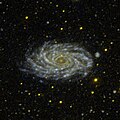NGC 2336
| Galaxie NGC 2336 | |
|---|---|
 | |
| Die Spiralgalaxie NGC 2336 aufgenommen mithilfe des Hubble-Weltraumteleskops | |
| AladinLite | |
| Sternbild | Giraffe |
| Position Äquinoktium: J2000.0, Epoche: J2000.0 | |
| Rektaszension | 07h 27m 03,6s[1] |
| Deklination | +80° 10′ 40″[1] |
| Erscheinungsbild | |
| Morphologischer Typ | SAB(r)bc / RET / Sy2[1] |
| Helligkeit (visuell) | 10,3 mag[2] |
| Helligkeit (B-Band) | 11,1 mag[2] |
| Winkelausdehnung | 7,1′ × 3,9′[2] |
| Positionswinkel | 178°[2] |
| Inklination | 59° |
| Flächenhelligkeit | 13.8 mag/arcmin²[2] |
| Physikalische Daten | |
| Zugehörigkeit | NGC 2336-Gruppe[3] |
| Rotverschiebung | 0.007352 ± 0.000003[1] |
| Radialgeschwindigkeit | (2204 ± 1) km/s[1] |
| Hubbledistanz H0 = 73 km/(s • Mpc) | (105 ± 8) · 106 Lj (32,2 ± 2,3) Mpc [1] |
| Durchmesser | 195.000 Lj[4] |
| Geschichte | |
| Entdeckung | Ernst Tempel |
| Entdeckungsdatum | 1876 |
| Katalogbezeichnungen | |
| NGC 2336 • UGC 3809 • PGC 21033 • CGCG 348-034 • 349-004 • MCG +13-06-006 • IRAS 07184+8016 • 2MASX J07270405+8010410 • 2MASS J07270376+8010419 • KPG 132A • WISEA J072703.74+801042.2 | |
NGC 2336 ist eine Balken-Spiralgalaxie mit aktivem Galaxienkern vom Hubble-Typ SBbc im Sternbild Giraffe am Nordsternhimmel. Sie ist schätzungsweise 105 Millionen Lichtjahre von der Milchstraße entfernt und hat einen Durchmesser von etwa 195.000 Lichtjahren. Gemeinsam mit IC 467 bildet sie das isolierte Galaxienpaar KPG 132und ist Namensgeber der NGC 2336-Gruppe.
Die Typ-Ia-Supernova SN 1987L wurde hier beobachtet.[5]
Das Objekt wurde im Jahr 1876 von dem deutschen Astronomen Ernst Wilhelm Leberecht Tempel[6] mit einem 28-cm-Teleskop entdeckt.
- UV-Aufnahme mittels GALEX
- Aufnahme mithilfe des 24-Zoll-Spiegelteleskops des Mount-Lemmon-Observatoriums
Literatur
- König, Michael & Binnewies, Stefan (2019): Bildatlas der Galaxien: Die Astrophysik hinter den Astrofotografien, Stuttgart: Kosmos, S. 135
Weblinks
- Walter Primik: Amateuraufnahme in Spektrum.de vom 20. Januar 2023
- CDS Portal
- Big, Beautiful and Blue (engl.)
Einzelnachweise
Auf dieser Seite verwendete Medien
NGC 2336 galaxy by GALEX
Autor/Urheber: Judy Schmidt, Lizenz: CC BY 2.0
Recent observations revealing the many-armed, beautiful spiral galaxy NGC 2336 as only Hubble can. The imagery used to create this image was taken in January 2020. Meanwhile, the Chandra X-ray Observatory is also tasked with looking at this galaxy, though I haven't looked into the details of that, yet.
Data from the following proposal was used to create this image: Determining How X-ray Binary Populations Vary Through Time
Note there are a number of blank areas in the image where data were absent. I filled those with background-matched noise to make them visually unobtrusive. Some other areas also lack a full range of color, being only covered by 1-2 filters.
Red: ACS/WFC F814W Green: ACS/WFC F555W Blue: ACS/WFC F435W
North is exactly to the right.Autor/Urheber: Credit Line and Copyright Adam Block/Mount Lemmon SkyCenter/University of Arizona, Lizenz: CC BY-SA 3.0 us
NGC 2336
Picture Details:
Optics 24-inch RC Optical Systems Telescope Camera SBIG STL11000 CCD Camera Filters Custom Scientific Dates December 30th-31st, 2008 Location Mount Lemmon SkyCenter Exposure LRGB = 150:40:30:40 minutes Acquisition TheSky (Software Bisque), Maxim DL/CCD (Cyanogen) Processing CCDStack (CCDWare), Mira (MiraMetrics), Maxim DL (Cyanogen), Photoshop CS3 (Adobe) Guest Astronomer: Bill NorthupCredit Line and Copyright Adam Block/Mount Lemmon SkyCenter/University of Arizona




